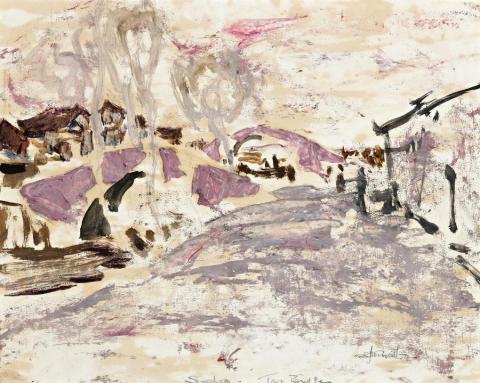SOOCHOW - TWO BRIDGES, 1933
IAN FAIRWEATHER
oil on paper on board
32.5 x 41.0 cm
signed lower right: I Fairweather
inscribed lower centre: Soochow - Two Bridges
Cynthia Reed's, Melbourne
Joseph Brown Gallery, Melbourne
Private collection, Melbourne, acquired from the above in 1980
Probably Ian Fairweather, Cynthia Reed's, Melbourne, March 1934
(Bridge in China), 1933, oil and gouache on paper, 40.0 x 60.0 cm, illus. in Bail, M., Fairweather, Murdoch Books, Sydney, revised edition 2009, p. 30, cat. 10, fig. 5
In his latest book, a mammoth and absorbing history of Australian art, the indefatigable Sasha Grishin perceptively observes of Ian Fairweather, 'He was a painter who rarely worked from life and in a way most of his works are memory paintings in which he was trying to resolve the problems of formal composition and paint application.'1 These brilliant resolutions enrich our art immeasurably, reflection being a key to the enjoyment of Soochow -Two Bridges, 1933. There is a ravishing beauty about his use of oil and gouache - seen again in (Chinese Mountain) and (River, Hangchow), both of 1933 and in the collection of the Art Gallery of New South Wales, Sydney - that makes the sighting of another work, (Bridge China), 1933, all the more desirable. Related in subject to our painting, and illustrated in Murray Bail's study of Fairweather, it is recorded as 'whereabouts unknown'. Nevertherless, they share a freedom of handling that is captivating, providing the eye has not already been totally seduced by the colour of Soochow -Two Bridges. The Balinese paintings of the same time are similarly unforgettable, (Head of a Woman), c1933 in the National Gallery of Victoria, Melbourne, and Bathing Scene, Bali, 1933 in the Tate Gallery, London, showing again the young artist in masterful stride. The appeal of his colour, so in harmony with the calligraphy of his brush strokes, is fascinating, given how limited Fairweather's palette is. On the absence of bright colours, Fairweather said, 'The Chinese manage to do their finest paintings with no colour at all ...'3 The pastel dry of his pigments adds a special earthiness, increasing the harmony between subject art.
Fairweather settled in Shanghai in the first part of 1929, living in a building looking over Soochow Creek, a bustle of people and sampans.4 It inspired many paintings, including Boats at Soochow Creek, 1938, painted nine years later when in the Philippines.5 The power of recall was so strong that it expresses all the immediacy of a work taken direct from the motif, often found in later painted Chinese subjects. The bridge, a ubiquitous feature of the river, occurs in many a Fairweather painting, the curved arch uniting the two banks of the landscape in reflection of the universal harmony within nature. Moreover, the shape itself is pleasing; Bridge, Huchow, 1941, another masterly work in the National Gallery of Victoria, affording triple the pleasure through its several arches. In Soochow -Two Bridges and elsewhere, the bridge can also be interpreted as a metaphor of Fairweather effortlessly bridging the arts of the East and West in his own.
1. Grishin, S., Australian Art: A History, Miegunyah Press, Melbourne University Publishing Limited, Melbourne, [2014], pp. 359, 361
2. Bail, M., Fairweather, Murdoch Books, Sydney, revised edition 2009, p. 30 (illus.)
3. Fairweather in 1974, quoted in Bail, ibid., p. 84
4. Soochow Creek, nowadays Suzhou, flows through the centre of Shanghai
5. See Deutscher and Hackett, Melbourne, 24 April 2013, lot 10
DAVID THOMAS
